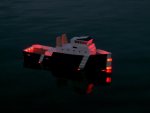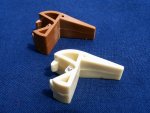Small Boat, Big Lights
 I've been busy working finishing some body work on the car recently. The
driver-side rear fender was in need of attention, as there was a significant
rust-rot infection. That's mostly cleared up now, but the paint job still
needs work.
I've been busy working finishing some body work on the car recently. The
driver-side rear fender was in need of attention, as there was a significant
rust-rot infection. That's mostly cleared up now, but the paint job still
needs work.
I took a small detour from the car work to make my little tug boat
water-ready enough to float around the pond tonight. This little boat is
about 45cm long, and is loaded with 27 LEDs. At one point it had running
gear, but with two Speed 400's it was very much overpowered. It was so
overpowered that it nearly tore itself apart.
This summer, I had hoped to revive it, and while that didn't happen, a
solid plan of action did get created. I'm going to buy cheap (tiny) aircraft
forward-only speed controls, and those will turn the two propellers
independently with slow motors. It is not necessary for the speed control to
have reversing, since it will be a slow boat and should be able to rotate in
place anyway. As an alternative, I am considering modified servos. They
might be enough, and would have reverse, in addition to being a fantastic
price for what amounts to a speed control, motor, and gearbox in one.
The photo does not do the model justice. The LEDs really lit it up.
[
] | posted @ 03:56 |
link
High Resolution AIGLX, Low Video Memory
After playing with XGL (and loving it) for a while on my home desktop (ATI
Radeon 9800), I thought that it needed a relatively powerful card to work.
However, at LinuxSymposium, I noticed a beat-up old ThinkPad R-series laptop
running it. I was told that the requirements to run AIGLX are much less
demanding.
Intrigued, I tried running AIGLX on my laptop, a Dell D600 (600m) with a
32 megabyte ATI Radeon 9000 M9; by no means powerful 3D hardware. At a
resolution of 1024x768, it worked very, very well, doing the same
compiz effects I could do under XGL on a much more powerful card with
proprietary drivers. However, running at my LCD's native resolution of
1400x1050, the desktop didn't draw completely: it clipped at 1024x1024.
At first, I figured the old hardware had a texture limitation of
1024x1024. Thankfully, since this was LinuxSymposium, I ran right to the man
who knows my hardware best, Adam Jackson. He told me that the 1K-texture
limit was artificial, and has to do with memory resources. Using glxinfo
-l, he showed me that GL_MAX_RECTANGLE_TEXTURE_SIZE_NV is the
texture size that would fit in the video texture memory, so that the card
could hold a certain number of textures, also listed in glxinfo. This value
could be overridden by telling the card to support large texture sizes in a
mysterious /etc/drirc XML file:
<driconf>
<device screen="0" driver="r200">
<application name="all">
<option name="allow_large_textures" value="2" />
</application>
</device>
</driconf>
This allowed textures to easily draw the full 1400x1050 I needed.
However, because of the sheer size of the textures and the small amount of
video memory I have, the number of textures that could be stored on the chip
went down significantly. Having a few large windows open (Desktop, Firefox,
Thunderbird) resulted in an extremely slow desktop experience, as the
textures had to be swapped in and out of the video memory for every frame
drawn.
So, while it didn't work out for me, perhaps this information will be
useful for people who have a little more video memory than I.
[
] | posted @ 22:06 |
link
PDP-8 Switches
 As reported
earlier this year, there is an effort (albeit slow) to get Carleton's PDP-8
working again. I volunteered to fix all of the programming switches.
As reported
earlier this year, there is an effort (albeit slow) to get Carleton's PDP-8
working again. I volunteered to fix all of the programming switches.
This morning, I've finally got something to show for it. I went out an
purchased the Alumilite starter kit, which came with enough mold rubber and
resin to get me started. At 40 dollars, it wasn't cheap. However, since I've
never had the opportunity to make a two-piece mold, this was the perfect
excuse to learn. The process works very well, and the resin sets in an
astonishing 3 minutes.
While the first copy isn't absolutely perfect, it should be good enough.
The main rocker hinge is made of stainless steel in my copy, so it won't
wear out too quickly. This is the same rod I'm retrofitting all of the
remaining original switches with, as all of the little nibs are in poor
condition or broken off completely.
All in all, the process was a success. I can crank these out fairly
quickly now. If there is interest from other PDP-8 owners to get some
replacement switches, I might even be interested in producing some for sale.
[
] | posted @ 17:46 |
link
 I've been busy working finishing some body work on the car recently. The
driver-side rear fender was in need of attention, as there was a significant
rust-rot infection. That's mostly cleared up now, but the paint job still
needs work.
I've been busy working finishing some body work on the car recently. The
driver-side rear fender was in need of attention, as there was a significant
rust-rot infection. That's mostly cleared up now, but the paint job still
needs work.

